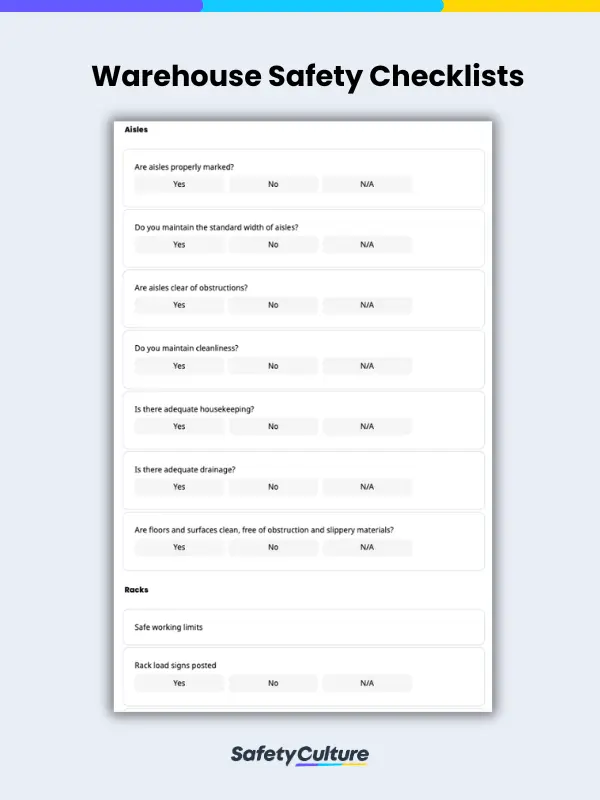What is a Warehouse Safety Checklist?
A warehouse safety checklist is used by safety officers and warehouse workers to identify safety hazards and come up with preventive measures to avoid accidents and injury. This tool is often enforced in warehouses to ensure that workers take precautionary measures inside the facility and ultimately protect assets and lives.
Why is Warehouse Safety important?
Warehouse safety has always been important, but its importance is heightened by increased shipment and storage of hazardous items and the handling of heavy machinery. It is important to establish a proper safety protocol, conduct regular safety training, follow a long-term and short-term housekeeping procedure, and have the proper safety products and equipment.
Warehouse Safety Steps
A lot of factors are considered when it comes to warehouse safety and keeping track of them all can be a little bit challenging. To help with that, below is a list of steps to follow or best practices to implement in order to keep warehouses safe:
- Promote general safety – Emphasize the importance of safety in every aspect of the business. Provide training and courses, boost hazard awareness, and communicate constantly with employees and third-party vendors or suppliers that also occupy the site.
- Use safety equipment – Utilize safety tools that help prevent injuries such as forklifts, guard rails, anti-slip tapes, etc. With this, be sure to follow protocols on shelving safety and vehicle safety—conduct training and observe safety practices constantly.
- Remove potential hazards – Enforce good housekeeping strategies and involve the employees in implementing them. To avoid workplace injury and damage to machinery— floors should be free from debris, liquids, unnecessary cords, cracks, and pits.
- Mark hazardous areas – As one of the most effective ways to keep a workplace safe, clearly indicate hazardous areas in your warehouse using safety signs and symbols. It is critical that equipment, harmful zones, and emergency exits, among others, are properly labeled and marked.
- Wear protective clothing – Similar to other danger-prone workplaces, practice the use of protective clothing such as hard hats, gloves, and eyewear, especially when in the area of operations. It is also encouraged to avoid loose-fitting clothes which can get caught in equipment or machinery.
- Conduct fire safety drills – Regularly conduct fire safety drills to ensure that all warehouse occupants are aware of the evacuation plan in case of emergencies. Drills also help ensure that fire alarms, smoke detectors, and emergency lights are all in good working conditions.
- Perform regular inspections – Raise your warehouse safety efforts by performing regular and random inspections. These assessments help ensure that safety protocols are consistently followed, enable you to identify areas where there are instances of non-conformance, and allow you to spot processes where safety can further be improved.
How are Warehouse Inspections Done?
Warehouse inspection may seem utterly overwhelming, but its importance cannot be argued as it can spell the difference between a safe warehouse operations day and a fatal accident. Fail it and your company could be out thousands of dollars;. Or worse, your hundreds of jobs—or even your business— may suddenly be in jeopardy.
With that, here are 4 key steps you can follow so you can ensure a comprehensive warehouse inspection:
Examine the Warehouse and Identify Opportunities for Improvement
Warehouse inspections are crucial to the prevention of accidents, injuries, and illnesses. An in-depth warehouse walkthrough can help identify and record potential risks for corrective action. With a warehouse audit checklist, you can ensure that you don’t miss inspections of specific areas because you have a comprehensive list of everything that needs to be checked. Complete and accurate inspection data ensure a safe working structure for you and your warehouse staff.
Review Warehouse Safety Program to Know Strengths and Gaps
A smart way to identify strengths and gaps in your warehouse safety program is to put it side by side with best safety practices for warehouse operations by OSHA and international regulatory bodies. Assess the workplace conditions to identify strong areas and duplicate its effects; on the other hand, you should also discover areas that need improvement with regard to compliance and traditional OSHA safety standards or international practices.You can note these findings on the warehouse inspection report and use it as a point of discussion for improvement with the management.
Develop a Strategy to Address Gaps
Remedial action for findings is the key to achieving warehouse safety audit success. Active effort from the management team will help implement changes to get the best results. Develop an action plan that lists all areas that need to be addressed to ensure that all aspects have been considered. This will also ensure the succeeding audits go smoothly.
Do More Than What Is Necessary
You need to take it up a notch and beyond minimum requirements if you want to provide the best safety measures for your warehouse employees. There are basic requirements to be met that can protect your workers from injury, and going beyond these will further develop a positive safety culture in your warehouse in the long-run.
Warehouse Safety Checklists Should Include What Items to Check?
Warehouse safety checklists should ensure that the following are checked:
- Aisles and open areas are clear and open
- Racks should be in good condition
- Fire extinguishers are regularly inspected and in good condition
- Overhead lighting fixtures are working and in good condition
- Loose/unboxed materials are properly stacked
- Derail and/or bumper blocks on spur railroad tracks
- Employees are in PPE when handling chemicals
- There are covers and/or guardrails to protect employees from fall hazards
- Elevators and hoists are used correctly for lifting materials
- Hazardous materials containers are properly labeled
- Dock doors are working properly and closed when not in use
- There is adequate ventilation
- Equipment is in good working condition
- Pest control is effective
- Training and evaluation in place for employees
SafetyCulture Marketplace: Your One-Stop Work Gear & Equipment Shop
Improve safety in your workplace with SafetyCulture Marketplace as your one-stop shop for all work gear and equipment needs. Get on-demand access to top quality and specialized work gear from trusted equipment brands in the industry—all in one centralized location. Raise the bar of safety and efficiency by empowering employees to request what they need with just a few taps, anytime and anywhere!



